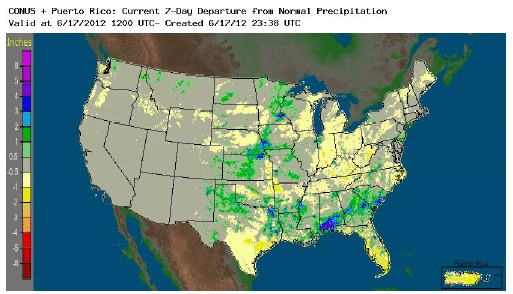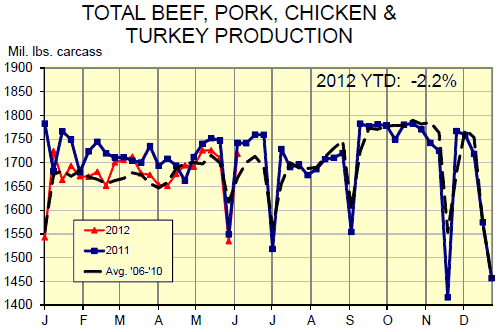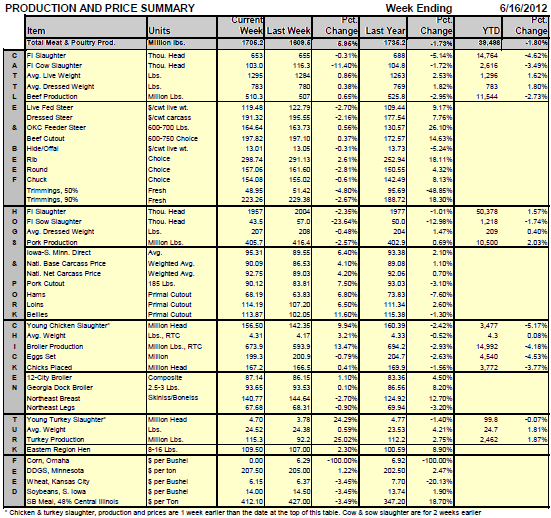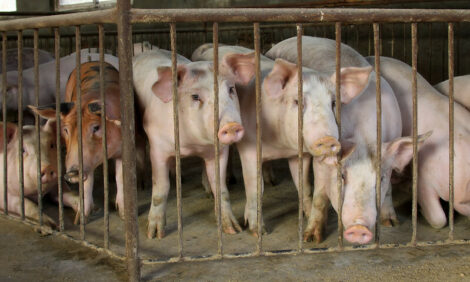



CME: Western Cornbelt Crops Get Rainfall
US - Western Cornbelt crops got a much needed drink (or perhaps just a sip) or water over the weekend with much of Iowa receiving rain, write Steve Meyer and Len Steiner.The rainfall was not often heavy but was
sufficient in most cases to buy some time for corn and soybeans
that were under some moisture stress. And it came just in time,
with forecast high temperatures in the mid-90s for the early part
of this week. That’s the good news. The bad news is two-fold.
First, the improvement of the past week is a temporary
fix. The longer-term situation still shows precipitation lagging the
normal pace, meaning drought conditions of varying degrees still
exist from Kansas and Nebraska in the west to Indiana in the
east. Northeast Nebraska and northwest Iowa are about the only
exceptions in those states. Meaning: There isn’t much subsoil
moisture to draw on. Rains have to come at proper times to
nourish crops in these areas.
The second piece of bad news is that the Eastern Cornbelt
received no such relief. Eastern Wisconsin, eastern Illinois
and the rest of the Ohio Valley states were already behind in rainfall
and remained so as of the National Weather Services’ computations
yesterday.
The net result is higher corn and soybean futures in
electronic trading. New crop corn is generally double-digit higher
while beans are 12-17 1/2 higher as of this writing. New crop
soybean meal contracts remain very near their contract life highs.

Weekly meat and poultry production remained well below year-ago levels last week but the amount of the cumulative year-on-year decline keeps getting smaller. Total beef, pork, chicken and turkey output for the week that ended 9 June (the latest data available on chicken and turkey) amounted to 1.742 billion pounds, 1.3 per cent less than during the same week last year. That year-on-year reduction is a bit larger than last week but not nearly as large and the 2 and 3 per cent drops seen earlier this year. The results is that year-to-date output using weekly data (as is shown in the chart at right) is now 2.2 per cent where it was lagging by 3 and 4 per cent as recently as March. Total meat and poultry output based on daily data (as is used in the top line of our Production and Price Summary) is down 1.8 per cent YTD as of last week.

The entire situation could move to the plus side in the
next couple of months. The reason is that chicken production,
which has led the year-on-year reductions most of the year and
stood at –5.2 per cent YTD as of two weeks ago, will move to the plus
side of the year-on-year ledger. That doesn’t mean output is
growing much — it just means we are catching up with last summer’s
Draconian cuts in egg sets and chick placements.
The offsetting change, however, will be beef output as
the lower feedyard placements that began in earnest back in December
play out in steer and heifer slaughter. The reductions in
steer and heifer numbers so far have been offset largely by higher carcass weights and we see no end to that situation — for reasons
discussed on several occasions in these pages. Fed cattle
weights have clearly made their seasonal low with steers the
week of 9 June rising 11 pounds in one week and, at 850 pounds
on average, exceeding their lightest weight of the year (the week
of 28 April) by over 20 pounds.
And that brings us to hogs. FI hog slaughter last week
was lower than one year ago for the first time since March 10. In
addition , Saturday’s 2000-head run was the lowest Saturday,
non-holiday total since four weeks in the spring and summer of
2010. It looks more and more that we did indeed pull some hogs
forward this spring as the cutout value rallies. It was up $2.54 on
Friday, led primarily by retail cuts — loins, butts and ribs. Every
penny of that was needed to keep packer margins respectable as
the national weighted average negotiated price hit $97.18 and the
Iowa-Minnesota negotiated price eclipsed $100/cwt,, up $3.74.







